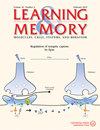Safety signals reinforce instrumental avoidance in humans
IF 1.8
4区 医学
Q4 NEUROSCIENCES
引用次数: 0
Abstract
Safety signals reinforce instrumental avoidance behavior in nonhuman animals. However, there are no conclusive demonstrations of this phenomenon in humans. Using human participants in an avoidance task, Experiments 1–3 and 5 were conducted online to assess the reinforcing properties of safety signals, and Experiment 4 was conducted in the laboratory. Participants were trained with CSs+ and CSs–, and they could avoid an aversive outcome during presentations of the CSs+ by pressing their space bar at a specific time. If successful, the aversive outcome was not presented but instead a safety signal was. Participants were then tested—whilst on extinction—with two new ambiguous test CSs. If participants made an avoidance response, one of the test CSs produced the trained safety signal and the other was a control. In Experiments 1 and 4, the control was followed by no signal. In Experiment 2, the control was followed by a signal that differed in one dimension (color) with the trained safety signal, and in Experiment 3, the control differed in two dimensions (shape and color) from the trained safety signal. Experiment 5 tested the reinforcing properties of the safety signal using a choice procedure and a new response during test. We observed that participants made more avoidance responses to the ambiguous test CSs when followed by the trained signal in Experiments 1, 3, 4, and 5 (but not in Experiment 2). Overall, these results suggest that trained safety signals can reinforce avoidance behavior in humans.安全信号会强化人类的工具回避行为
安全信号会强化非人类动物的工具性规避行为。然而,这种现象在人类身上还没有确凿的证据。为了评估安全信号的强化特性,实验 1-3 和实验 5 在网上进行,实验 4 在实验室进行。参与者接受了 CSs+ 和 CSs- 的训练,在 CSs+ 出现时,他们可以通过在特定时间按下空格键来避免厌恶结果。如果成功,则不会出现厌恶结果,而是会出现一个安全信号。然后,参与者在消退过程中接受两个新的模棱两可的 CS 测试。如果参与者做出回避反应,其中一个测试 CS 就会产生经过训练的安全信号,而另一个则是对照组。在实验 1 和 4 中,对照组之后没有信号。在实验 2 中,对照组之后的信号在一个维度(颜色)上与训练过的安全信号不同;在实验 3 中,对照组之后的信号在两个维度(形状和颜色)上与训练过的安全信号不同。实验 5 利用选择程序和测试期间的新反应测试了安全信号的强化特性。我们观察到,在实验 1、3、4 和 5 中(但在实验 2 中没有观察到),当被试在训练信号后对模棱两可的测试 CS 做出更多的回避反应。总之,这些结果表明,训练过的安全信号可以强化人类的回避行为。
本文章由计算机程序翻译,如有差异,请以英文原文为准。
求助全文
约1分钟内获得全文
求助全文
来源期刊

Learning & memory
医学-神经科学
CiteScore
3.60
自引率
5.00%
发文量
45
审稿时长
6-12 weeks
期刊介绍:
The neurobiology of learning and memory is entering a new interdisciplinary era. Advances in neuropsychology have identified regions of brain tissue that are critical for certain types of function. Electrophysiological techniques have revealed behavioral correlates of neuronal activity. Studies of synaptic plasticity suggest that some mechanisms of memory formation may resemble those of neural development. And molecular approaches have identified genes with patterns of expression that influence behavior. It is clear that future progress depends on interdisciplinary investigations. The current literature of learning and memory is large but fragmented. Until now, there has been no single journal devoted to this area of study and no dominant journal that demands attention by serious workers in the area, regardless of specialty. Learning & Memory provides a forum for these investigations in the form of research papers and review articles.
 求助内容:
求助内容: 应助结果提醒方式:
应助结果提醒方式:


